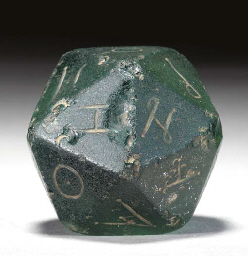Christie’s in New York is auctioning a 2nd century ad Roman dice that looks suspiciously like an RPG d20 dice:

[Link courtesy of Philip Tan.]
Does anybody know the history of the d20? I was pretty convinced that it was of newer origin.
(Yes, I know, I placed this in the “games” category even though I claim that RPGs aren’t really games.)

Try this link …
http://isgwww.cs.uni-magdeburg.de/~pelo/s1e/sa1/sa11.shtml#HistMod
Oops, maybe I should add a few more words: a d20 dice is obviously an icosaeder, i. e. a Platonic body (regular convex polyhedron) – and as the term suggests, they are known at least since Platon. Quite a long time, actually. And the people in ancient Greece and the Roman Empire loved to play games, even if it were not really RPG at this time. So it seems quite natural that already they were using icosaeders as dice.
Yep, it’s a Platonic solid. The dice that were originally shipped with the brown-box edition of D&D were, in fact, a complete set of Platonic solids manufactured for educational, not gaming purposes (tetrahedron, cube, octohedron, dodecahedron, and icosahedron. (They also sucked as dice; the plastic was quite soft, and they wore down very quickly. Once the game caught on, hobby games manufacturers started making more durable multisided dice.)
The British Museum has had Roman gaming dice on display for some decades, including an icosahedron. So this isn’t “new news,” per se.